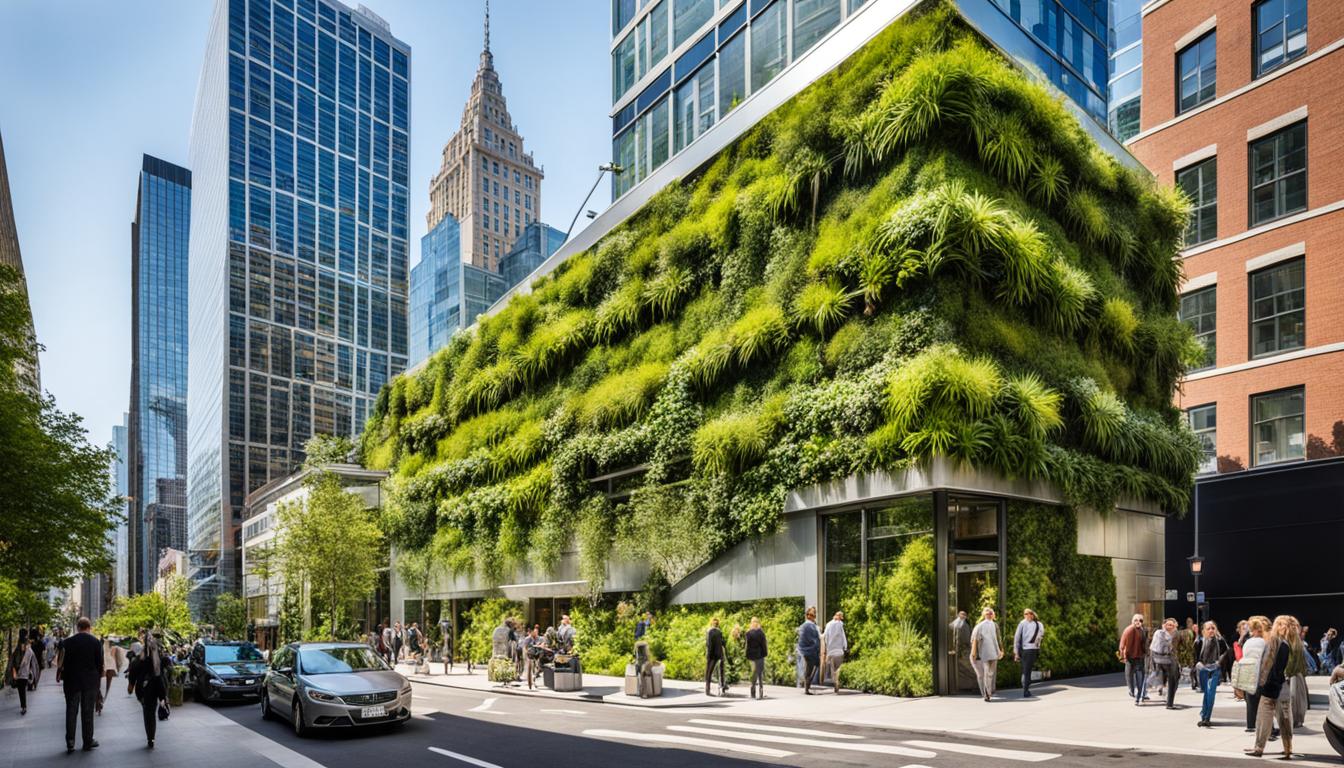
Imagine a bustling city with towering skyscrapers, crowded streets, and a never-ending stream of traffic. The noise, pollution, and concrete jungle can often feel overwhelming. But what if there was a way to bring nature back into the heart of the city? What if architects could create urban oases, vibrant spaces that not only provide a breath of fresh air but also promote biodiversity and sustainable living?
Meet Emily, a dedicated architect with a passion for sustainable design and ecological architecture. In her quest to bring greenery and life to the urban landscape, Emily has embarked on a mission to transform neglected city spaces into thriving ecosystems. She believes that every rooftop, every pocket of land, and every abandoned lot holds the potential to become a lush oasis.
With her innovative ideas and determination, Emily has learned to navigate the challenges of limited space and scarce resources. She has discovered how to turn concrete rooftops into blooming gardens and empty lots into serene parks. She understands that sustainable urban planning and landscape ecology are essential in creating biodiverse cityscapes that benefit both humans and the environment.
Join Emily on her journey as she explores the world of urban oasis designs, discovers sustainable practices, and learns how to embrace green urbanism. Through her experiences, you’ll gain insights into the strategies architects can employ to create biodiverse cityscapes and become advocates for a greener and more sustainable future.
Key Takeaways:
- Architects play a crucial role in creating urban oases and promoting biodiversity through sustainable design and ecological architecture.
- Urban oasis designs can transform concrete jungles into breathtaking natural spaces that improve air quality, reduce noise pollution, and enhance overall well-being.
- Green infrastructure, rooftop gardens, and other innovative techniques are used to overcome challenges in urban landscaping and promote sustainability.
- Stunning examples like High Line Park, Gardens by the Bay, and Bosco Verticale showcase the possibilities of creating vibrant urban oases.
- By incorporating potted plants, water features, and natural materials, anyone can create their own urban oasis and embrace sustainable living.
Understanding the Concept of Urban Oasis
An urban oasis is a carefully planned and executed landscaping project that transforms concrete jungles into breathtaking natural spaces. It involves creating green spaces that provide relaxation, stress relief, improved air quality, reduced noise pollution, and increased property values. Despite facing challenges such as limited space, poor soil quality, and lack of water sources, urban oasis designers use innovative techniques like vertical gardening and rooftop gardens to overcome these obstacles.
One of the primary goals of an urban oasis is to promote sustainability. Designers incorporate sustainable practices like rainwater harvesting and composting to address water shortage issues and improve soil fertility. By prioritizing sustainability, urban oasis projects contribute to creating environmentally friendly and resilient cities.
Creating an urban oasis goes beyond aesthetic appeal. It aims to provide a harmonious blend of nature and urban living, offering a peaceful respite amid the hustle and bustle of city life. These green spaces not only benefit humans but also support local flora and fauna, promoting urban biodiversity.
“An urban oasis is a perfect synergy between nature and urban development. It creates an environment where people can relax, connect with nature, and experience the benefits of green spaces.” – Jane Thompson, Urban Oasis Designer
Urban oasis projects utilize various landscaping techniques to maximize limited space and overcome challenges. Vertical gardening allows for greenery to be integrated into vertical structures, such as walls or fences, adding a touch of nature to urban landscapes. Rooftop gardens offer the opportunity to create green spaces in otherwise unused areas, promoting biodiversity while regulating temperature and reducing energy consumption.

By incorporating sustainable design principles, urban oases contribute to the overall well-being of urban dwellers. They serve as havens of tranquility, providing a space for relaxation and rejuvenation amidst the urban chaos. Through careful planning and execution, architects and designers can create urban oases that not only enhance the quality of life but also promote the long-term sustainability of our cities.
| Benefits of Urban Oasis | Techniques Used |
|---|---|
|
|
Types of Urban Landscaping
When it comes to transforming urban areas into green havens, there are various types of urban landscaping practices that architects can employ. These practices not only enhance the aesthetics of the city but also provide numerous environmental benefits. By integrating natural elements into urban design, cities can combat the challenges posed by urbanization and create sustainable and biodiverse urban oases.
Green Infrastructure
One popular approach to urban landscaping is the implementation of green infrastructure. Green infrastructure involves the strategic integration of vegetation and natural elements throughout the city to provide multiple benefits. These benefits include the reduction of air pollution, mitigation of the urban heat island effect, and effective management of stormwater. By incorporating green infrastructure into urban landscapes, architects can create visually appealing environments that prioritize sustainability and the well-being of city dwellers.
Rooftop Gardens
In densely populated cities with limited space, rooftop gardens have emerged as a sustainable and innovative solution for urban landscaping. These gardens make use of underutilized rooftop spaces, turning them into vibrant green areas that offer numerous advantages. Rooftop gardens contribute to energy efficiency by regulating temperature and reducing the heat island effect. They also enhance the aesthetics of buildings and provide opportunities for urban agriculture. By embracing rooftop gardens, architects can optimize the use of urban spaces and transform them into lush and functional areas.
Urban Landscaping Practices for Sustainable Future
The growing trend of urbanization calls for sustainable practices in urban landscaping. Embracing green infrastructure and rooftop gardens is a step towards creating sustainable and biodiverse cities. These practices not only contribute to the well-being of city dwellers but also mitigate the environmental impacts of urbanization. By incorporating elements of nature into the urban fabric, architects can foster a harmonious coexistence between humans and the environment.
| Benefits of Green Infrastructure | Advantages of Rooftop Gardens |
|---|---|
| – Reduction of air pollution | – Regulation of temperature |
| – Mitigation of the urban heat island effect | – Reduction of the heat island effect |
| – Effective stormwater management | – Enhanced aesthetics of buildings |
| – Increased biodiversity | – Opportunities for urban agriculture |
Examples of Stunning Urban Oasis Designs
When it comes to creating urban oasis designs, certain landmarks stand out for their breathtaking beauty and innovative approaches to urban landscaping. Three notable examples that showcase the transformative power of greenery in urban environments are High Line Park, Gardens by the Bay, and Bosco Verticale.
High Line Park
High Line Park, located in New York City, is a remarkable urban oasis that has reclaimed an abandoned railway line and transformed it into a lush green space. The park spans over 1.45 miles and offers stunning views of the city skyline. Visitors can stroll along elevated walkways, surrounded by vibrant flora, and enjoy a peaceful retreat from the bustling streets below. High Line Park beautifully combines urban and natural elements, creating a harmonious blend of greenery and urban architecture.
Gardens by the Bay
Gardens by the Bay in Singapore is a futuristic and immersive urban oasis featuring breathtaking Supertrees and indoor gardens. These Supertrees are vertical gardens that tower up to 50 meters and are adorned with a variety of plants, including ferns, orchids, and bromeliads. The Supertree Grove is a sight to behold, especially when illuminated at night. With its iconic structures and extensive collection of plants, Gardens by the Bay offers visitors an awe-inspiring experience that showcases the possibilities of urban landscaping.
Bosco Verticale
Bosco Verticale, or “Vertical Forest,” in Milan, Italy, is an architectural wonder that exemplifies sustainable urban living. These two residential towers are covered in lush greenery, with each balcony housing trees and plants. Bosco Verticale serves as a testament to the potential of incorporating greenery into urban spaces, providing ample opportunities for air purification, noise reduction, and biodiversity. This innovative concept showcases the concept of vertical gardens taken to new heights, creating a sustainable and visually stunning urban oasis.
These examples of urban oasis designs demonstrate the transformative power of incorporating greenery into urban landscapes. High Line Park, Gardens by the Bay, and Bosco Verticale showcase the beauty and potential of urban landscaping, proving that even in the midst of a concrete jungle, greenery can thrive and create a harmonious coexistence between nature and the built environment.
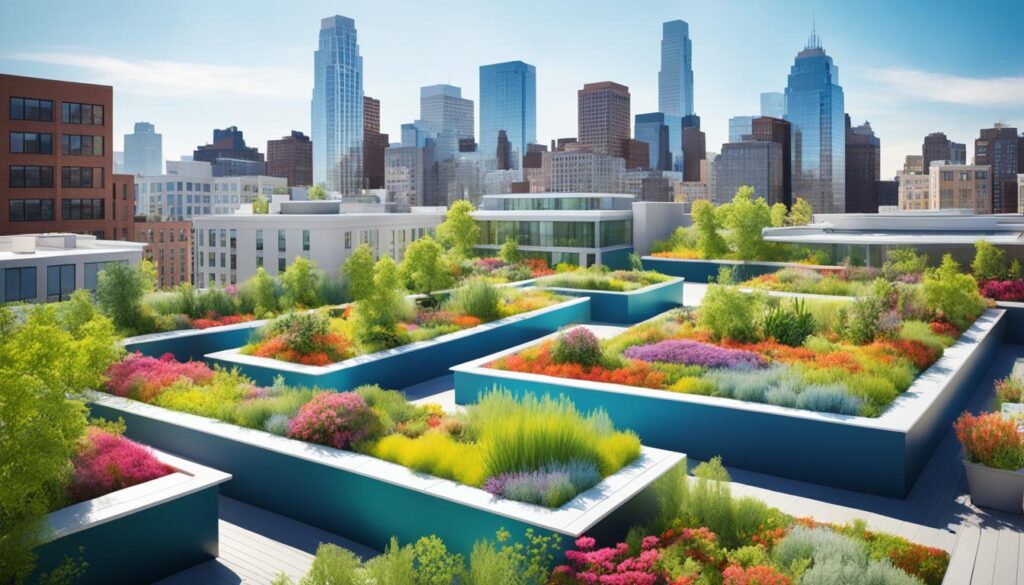
Creating Your Own Urban Oasis
Create your own DIY urban oasis by incorporating potted plants, hanging gardens, and refreshing water features like fountains or ponds. Use natural materials such as wood and stone to bring a sense of tranquility to your space. With clever vertical gardening techniques, you can maximize the utilization of even the smallest balconies or backyards, transforming them into tranquil retreats. By taking inspiration from nature and embracing sustainable living practices, you can build a budget-friendly green paradise right in the heart of the city.
Transforming your urban space into an oasis not only adds a touch of greenery but also provides a peaceful sanctuary away from the bustling city streets. Whether you have a spacious garden or a compact balcony, there are numerous ways to create your own urban oasis. Let’s explore some ideas to help you get started:
1. Potted Plants and Hanging Gardens
Add a splash of greenery to your space by incorporating potted plants and hanging gardens. Choose a variety of plants that thrive in your local climate and provide a lush, vibrant atmosphere. Hanging gardens are a great option for maximizing space, allowing you to enjoy greenery even in limited areas.
2. Water Features
Integrate water features such as fountains or ponds to create a soothing ambiance in your urban oasis. The sound of flowing water can help mask city noises, promoting tranquility and relaxation. Consider incorporating a small water feature that fits the scale of your space, whether it’s a tabletop fountain or a miniature pond.
3. Natural Materials
Use natural materials like wood and stone to enhance the organic feel of your urban oasis. Incorporate wooden furniture, decks, or pathways to create a harmonious connection with nature. Stone features, such as stepping stones or a stone wall, add texture and character to your space.
4. Vertical Gardening
Make the most of limited space by utilizing vertical gardening techniques. Install wall-mounted planters or vertical garden systems to grow herbs, flowers, or even vegetables in a space-saving manner. Vertical gardens not only add greenery but also serve as living walls, filtering indoor air and improving the overall air quality of your urban oasis.
Remember, sustainable living plays a crucial role in creating your urban oasis. Embrace eco-friendly practices like composting, using organic fertilizers, and conserving water to ensure your oasis remains environmentally friendly. Create a space that not only benefits you but also contributes to the overall well-being of the city and promotes biodiversity.
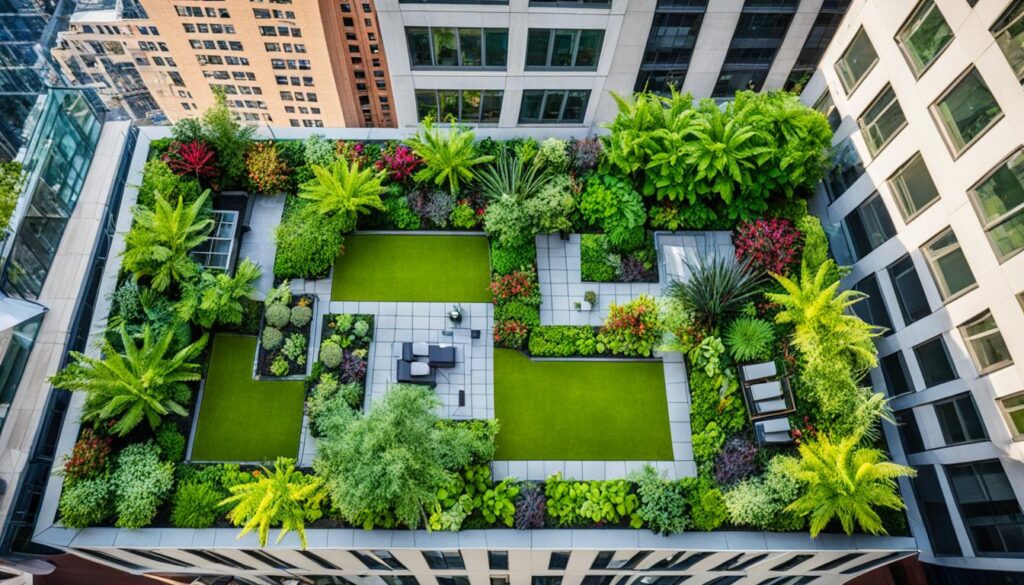
“In the midst of the bustling city, create an oasis of tranquility and greenery that rejuvenates your senses and provides a respite from urban chaos.”
With a little creativity and a touch of green, you can transform your urban space into a budget-friendly haven of tranquility and sustainability. Let your DIY urban oasis become a testament to the beauty of sustainable living amidst the vibrant energy of the city.
The Future of Urban Oasis
The future of urban oasis lies in sustainable development and the integration of green spaces into cities. By designing landscapes that incorporate natural elements, we can create a more balanced ecosystem and reduce our carbon footprint. Urban green spaces not only provide aesthetic value but also contribute to overall well-being by improving health and providing a peaceful respite from the urban chaos. Challenges such as limited space and resources can be overcome with creative solutions and innovation.
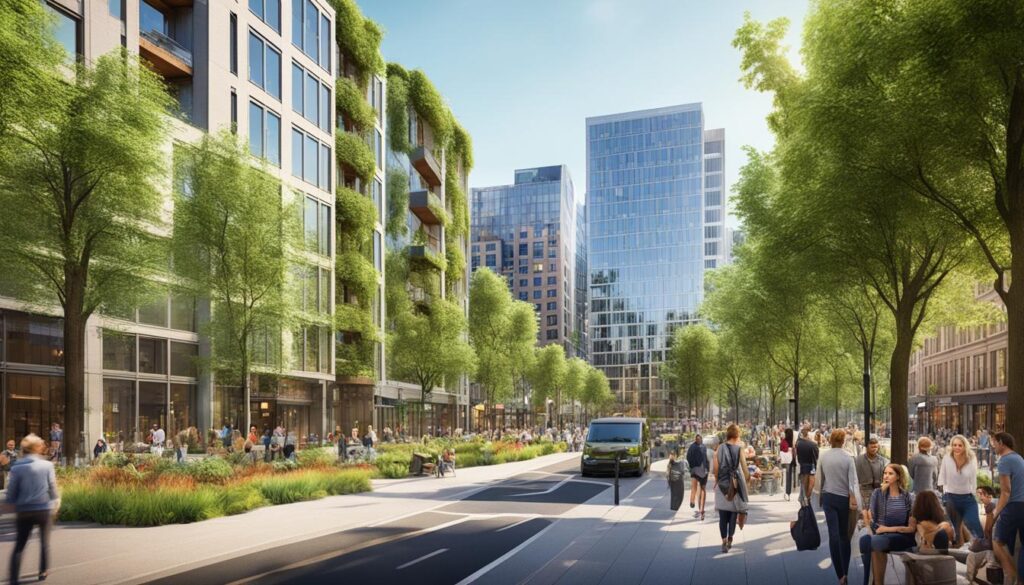
As cities continue to expand and urbanization intensifies, the need for sustainable development becomes increasingly crucial. Incorporating green spaces into urban areas offers numerous benefits, ranging from enhancing biodiversity to improving air quality. The integration of greenery into urban landscapes helps to combat the negative consequences of rapid urban growth.
A study conducted by Journal of Environmental Planning and Management found that increasing green spaces in cities can significantly reduce the carbon footprint. Trees and plants absorb carbon dioxide, a major contributor to climate change, through photosynthesis. By incorporating green spaces into cities, we can mitigate the impact of urbanization on the environment.
“The integration of green spaces into urban areas is not only aesthetically pleasing but also essential for promoting sustainable development. By creating a more biodiverse and ecologically balanced environment, we can enhance the overall quality of urban life.”
Moreover, green spaces in cities play a vital role in promoting biodiversity. As urbanization intensifies, natural habitats are often lost. By incorporating green spaces and preserving existing natural areas, we can provide habitats for various plant and animal species. This, in turn, helps to maintain ecological balance and supports the survival of important pollinators like bees and butterflies.
Benefits of Green Spaces in Urban Areas:
- Improves air quality by reducing pollution
- Reduces urban heat island effect
- Enhances mental well-being and reduces stress
- Provides spaces for recreation and physical activity
- Supports biodiversity and protects wildlife
In order to overcome challenges such as limited space and resources, architects and urban planners must employ innovative and creative solutions. Vertical gardens, rooftop gardens, and pocket parks are some examples of how limited space can be utilized to create green oases within urban environments.
By embracing sustainable practices and implementing green infrastructure, cities can pave the way for a greener and more livable future. Policies that prioritize the integration of green spaces, sustainable transportation, and energy-efficient buildings are key to achieving sustainable development goals.
The future of urban oasis lies in our ability to create sustainable cities that prioritize the well-being of both humans and the environment. Through thoughtful design, innovation, and the integration of green spaces, we can make our cities more beautiful, vibrant, and environmentally friendly.
Role of Urban Landscaping in Sustainable Development
Urban landscaping plays a crucial role in sustainable development by incorporating green spaces and natural elements into cities. By designing landscapes that support biodiversity and create a balanced ecosystem, we can reduce the environmental impact of urbanization and contribute to the well-being of both humans and wildlife. Sustainable urban planning and ecological architecture are essential in creating biodiverse cityscapes that promote a more sustainable and resilient future.
Urban landscaping involves the intentional design and implementation of green spaces within urban areas. These spaces not only provide aesthetic value but also serve as vital components of urban ecosystems. By integrating sustainable practices into urban landscaping projects, architects and city planners can create environments that are not only visually appealing but also environmentally friendly.
One of the key benefits of urban landscaping is the promotion of biodiversity. By incorporating a variety of plant species, urban landscapes can support a wide range of flora and fauna, thereby creating habitats and food sources for different species. This helps to maintain a healthy ecosystem within the city and preserves the natural balance of the environment.
In addition, urban landscaping contributes to the overall well-being of city dwellers. Green spaces provide opportunities for recreation, relaxation, and connection with nature. Access to nature has been proven to have positive effects on mental health, reducing stress and improving overall quality of life.
Furthermore, sustainable practices in urban landscaping can have a positive impact on the surrounding environment. These practices include the use of native plants, efficient irrigation systems, rainwater harvesting, and sustainable waste management. By incorporating these practices, urban landscapes can reduce water consumption, decrease reliance on artificial fertilizers and pesticides, and minimize waste generation.
Urban landscaping creates a harmonious blend of nature and urban life, bringing the benefits of green spaces to the heart of the city.
Benefits of Urban Landscaping in Sustainable Development
1. Enhances biodiversity: By incorporating diverse plant species, urban landscapes create habitats for various wildlife and support a healthy ecosystem.
2. Improves air quality: Trees and plants in urban landscapes absorb pollutants and release oxygen, improving the air quality in the city.
3. Reduces urban heat island effect: Green spaces help to lower temperatures by providing shade and evaporative cooling, reducing the urban heat island effect.
4. Manages stormwater runoff: Sustainable landscaping techniques like permeable pavements and green roofs help to manage stormwater runoff, preventing flooding and water pollution.
5. Enhances community well-being: Access to green spaces promotes physical and mental well-being, providing opportunities for relaxation, exercise, and social interaction.
| Benefits of Urban Landscaping | Description |
|---|---|
| Enhances biodiversity | By incorporating diverse plant species, urban landscapes create habitats for various wildlife and support a healthy ecosystem. |
| Improves air quality | Trees and plants in urban landscapes absorb pollutants and release oxygen, improving the air quality in the city. |
| Reduces urban heat island effect | Green spaces help to lower temperatures by providing shade and evaporative cooling, reducing the urban heat island effect. |
| Manages stormwater runoff | Sustainable landscaping techniques like permeable pavements and green roofs help to manage stormwater runoff, preventing flooding and water pollution. |
| Enhances community well-being | Access to green spaces promotes physical and mental well-being, providing opportunities for relaxation, exercise, and social interaction. |
In conclusion, urban landscaping is a powerful tool for sustainable development. By incorporating green spaces, sustainable practices, and ecological design principles, we can create biodiverse cityscapes that benefit both the environment and the well-being of urban dwellers. It is essential for architects, city planners, and policymakers to prioritize and invest in urban landscaping to build resilient, sustainable, and livable cities for future generations.

Choose Native Plants to Support Pollinators
Incorporating native plants in urban landscapes is crucial for supporting pollinators such as bees and butterflies. Native plants are well-adapted to urban environments, require less maintenance, and attract pollinators. By choosing native species like lavender, coneflower, and milkweed, architects can create urban oases that support biodiversity and provide a vibrant ecosystem in the midst of the city.
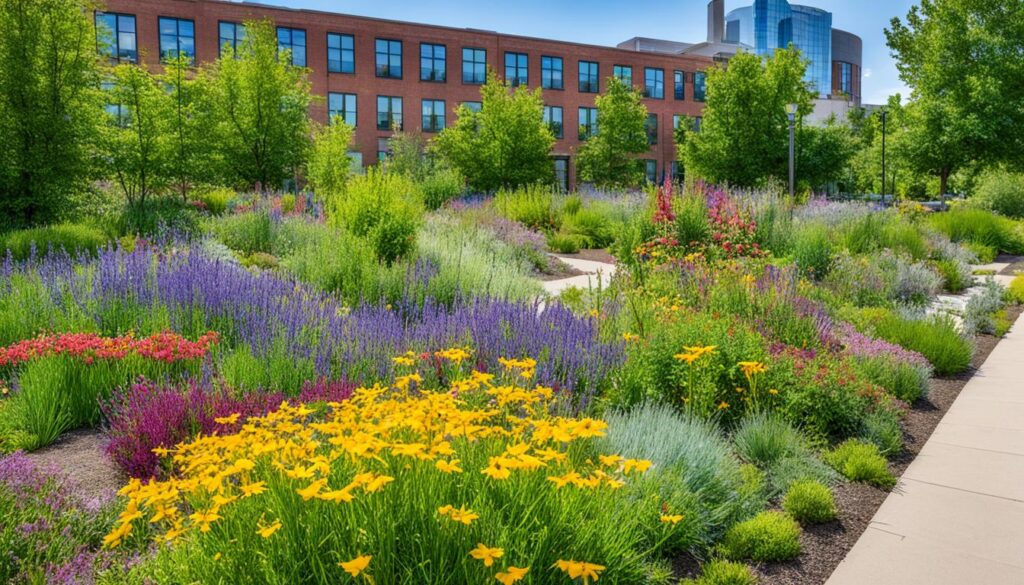
Native plants are essential for maintaining a healthy urban environment. They have evolved to thrive in the local climate, soil conditions, and pests, making them resilient and more likely to survive in urban landscapes. These plants also provide food and habitat for pollinators, which are crucial for biodiversity and ecosystem stability.
Benefits of Native Plants for Urban Environments
Choosing native plants for urban landscapes offers a range of benefits:
- Pollinator support: Native plants attract and provide food for pollinators such as bees, butterflies, and hummingbirds. This promotes pollination and ensures the reproduction of plants, contributing to the sustainability of urban ecosystems.
- Biodiversity preservation: By incorporating native plants, architects can create habitats for a variety of plant and animal species, thus preserving biodiversity in urban areas. This helps maintain a balance in the ecosystem and supports overall ecological health.
- Reduced maintenance: Native plants are well-suited to local environmental conditions, reducing the need for excessive watering, fertilizers, and pesticides. They are naturally adapted to the climate, requiring less maintenance and contributing to sustainable landscaping practices.
- Water conservation: Native plants have deep root systems that help absorb and retain water, reducing stormwater runoff and erosion. This contributes to water conservation efforts and helps maintain the health of urban waterways.
Incorporating native plants in urban landscapes not only enhances the aesthetic appeal but also creates a sustainable environment that supports a rich diversity of pollinators and other wildlife.
Architects have a responsibility to design urban spaces that prioritize biodiversity and sustainability. By selecting and integrating native plants into their projects, they can create thriving urban oases that not only benefit the environment but also provide a peaceful and vibrant experience for residents and visitors.
Embrace Green Roofs
Green roofs are an innovative solution for creating green spaces in urban areas. These roofs are covered with vegetation, providing numerous benefits for both the environment and human well-being. By integrating green roofs into architectural designs, architects can enhance urban sustainability and contribute to the creation of vibrant urban oases.
One of the key advantages of green roofs is their positive impact on energy efficiency. The layer of vegetation acts as insulation, reducing the need for heating and cooling. This natural insulation not only lowers energy consumption but also helps combat the urban heat island effect. Green roofs absorb less heat than traditional roofing materials, keeping cities cooler and reducing the demand for air conditioning.
Furthermore, green roofs play a crucial role in stormwater management. They absorb rainwater, preventing it from overwhelming urban drainage systems and reducing the risk of flooding. The vegetation on green roofs helps filter and purify rainwater, improving its quality before it enters waterways.
“Green roofs provide a unique opportunity to create natural habitats in the heart of the city, contributing to urban biodiversity,” says Jane Brown, a leading architect specializing in sustainable designs.
In addition to their environmental benefits, green roofs also offer aesthetic value and create a sense of natural tranquility in urban environments. They provide additional green spaces for recreational activities and enhance the overall well-being of city dwellers.
To showcase the benefits and practicality of green roofs, let’s take a look at the following table:
| Benefits of Green Roofs | Examples of Green Roof Projects |
|---|---|
|
|
As depicted in the table, green roofs offer multiple benefits ranging from energy efficiency to stormwater management. Projects like the Chicago City Hall Green Roof and Vancouver Convention Centre Green Roof have successfully showcased how green roofs can be integrated into urban settings to promote sustainability.
To visually illustrate the concept of green roofs, here is an image showcasing a beautiful example:
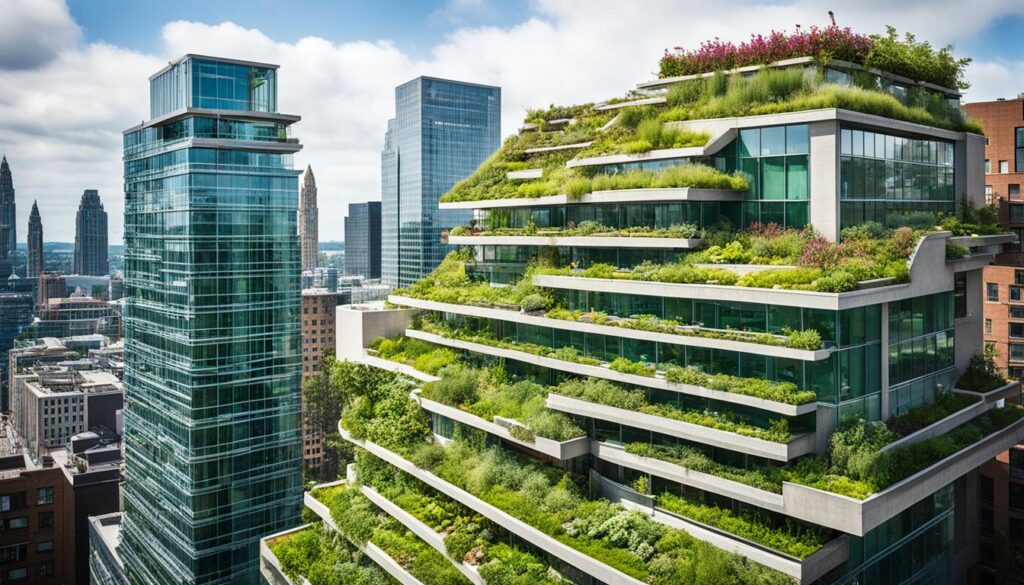
In conclusion, embracing green roofs is a vital step in improving urban sustainability and creating vibrant urban oases. Architects can lead the way by incorporating green roofs into their designs, providing multiple benefits such as energy efficiency, stormwater management, and the promotion of urban biodiversity. Let’s work together to build greener and more sustainable cities for future generations.
Conclusion
Architects have a unique opportunity to shape the future of our cities by embracing sustainable urban planning and ecological architecture. Through their careful design choices, they can transform urban landscapes into biodiverse cityscapes that prioritize the well-being of both humans and the environment.
By incorporating green spaces, such as parks and gardens, architects can create urban oases that not only beautify the city but also provide crucial habitats for urban biodiversity. Native plants play a vital role in supporting pollinators and creating vibrant ecosystems in the heart of the city.
Innovative designs like green roofs not only enhance the aesthetics of buildings but also contribute to energy efficiency, stormwater management, and urban sustainability. These sustainable practices foster a greener and more environmentally friendly urban environment, reducing our carbon footprint and improving the overall quality of life for urban dwellers.
As we move towards a more sustainable future, architects must continue to prioritize sustainable urban planning and ecological architecture. By doing so, they can help build a greener and more biodiverse future for our cities, where urban biodiversity thrives, and residents can enjoy the many benefits of green urbanism.
FAQ
What is an urban oasis?
An urban oasis is a carefully planned and executed landscaping project that transforms concrete jungles into breathtaking natural spaces. It offers relaxation and stress relief, improves air quality, reduces noise pollution, and increases property values.
What role do architects play in creating biodiverse cityscapes?
Architects play a crucial role in creating biodiverse cityscapes by incorporating sustainable design principles and ecological architecture. They can design landscapes that support biodiversity, incorporate green spaces, and embrace innovative solutions like green roofs and native plants.
What are some challenges architects face when creating urban oases?
Architects face challenges such as limited space, poor soil quality, and lack of water sources when creating urban oases. However, they overcome these obstacles through techniques like vertical gardening, rooftop gardens, rainwater harvesting, and composting.
Can you provide examples of stunning urban oasis designs?
Yes, some examples of stunning urban oasis designs include High Line Park in New York City, Gardens by the Bay in Singapore, and Bosco Verticale in Milan. High Line Park transformed an abandoned railway into a lush park with stunning views of the city, while Gardens by the Bay features futuristic Supertrees and indoor gardens. Bosco Verticale showcases twin towers covered in trees and plants, serving as both an architectural wonder and a sustainable solution to urban living.
How can individuals create their own urban oasis?
Individuals can create their own urban oasis by incorporating potted plants, hanging gardens, water features like fountains or ponds, and using natural materials like wood and stone. Vertical gardening techniques can maximize space utilization, and thoughtful design can transform even small balconies or backyards into tranquil retreats.
What is the future of urban oasis?
The future of urban oasis lies in sustainable development and the integration of green spaces into cities. By designing landscapes that incorporate natural elements, we can create a more balanced ecosystem and reduce our carbon footprint.
What is the role of urban landscaping in sustainable development?
Urban landscaping plays a crucial role in sustainable development by incorporating green spaces and natural elements into cities. By designing landscapes that support biodiversity and create a balanced ecosystem, we can reduce the environmental impact of urbanization and contribute to the well-being of both humans and wildlife.
How can architects support pollinators in urban environments?
Architects can support pollinators in urban environments by incorporating native plants in urban landscapes. Native plants are well-adapted to urban environments, require less maintenance, and attract pollinators like bees and butterflies.
What are the benefits of green roofs?
Green roofs are an innovative solution for creating green spaces in urban areas. They improve energy efficiency, reduce the urban heat island effect, effectively manage stormwater runoff, and provide habitats for plants and wildlife, contributing to urban biodiversity.
What is the importance of sustainable urban planning and ecological architecture?
Sustainable urban planning and ecological architecture are essential in creating biodiverse cityscapes that promote a more sustainable and resilient future. By incorporating green spaces, native plants, and innovative designs, architects can transform concrete jungles into thriving urban oases.

1 comment on “Urban Oasis: How Architects Can Create Biodiverse Cityscapes”